Urban Sprawl Sustainability of Mountainous Cities in the Context of Climate Change Adaptability Using a Coupled Coordination Model: A Case Study of Chongqing, China
Abstract
1. Introduction
2. Analysis of Coupling Mechanism between Urban Sprawl and Climate Change
2.1. Climate Change Affects Urban Sprawl
2.1.1. Climate Change Affects Urban Population Sprawl
2.1.2. Climate Change Affects Urban Infrastructure
2.1.3. Climate Change Affects Energy Activities
2.2. Effects of Urban Sprawl on Climate Change
2.2.1. Impact of Population Sprawl on Climate Change
2.2.2. Impact of Economic Sprawl on Climate Change
2.2.3. Impact of Spatial Sprawl on Climate Change
3. Materials and Methods
3.1. Study Area
3.2. Data Processing
3.3. Methods
3.3.1. Indicators for Urban Sprawl Sustainability and Climate Change Adaptability
3.3.2. The Weight of Each Indicator
3.3.3. Measuring Levels of USS and CCA
3.3.4. The Coupled Coordination Degree Model
3.3.5. Level and Grade of Coordination Degree of USS and CCA
4. Results and Discussion
4.1. Time Series Evolution Law of Coordinated Development Degree between USS and CCA in Chongqing Metropolitan Area
4.2. Spatial Difference Analysis of Coordinated Degree of USS and CCA in Chongqing Metropolitan Area
4.2.1. Slightly Coordinated Development with Lagging CCA
4.2.2. Slightly Coordinated Development with Lagging USS
4.2.3. Moderately Coordinated Development with Lagging CCA
5. Conclusions and Policy Implication
Author Contributions
Funding
Conflicts of Interest
References
- Qing, D. Climate change science and human sustainable development. Prog. Geogr. 2014, 33, 874–883. [Google Scholar]
- Huang, J.P.; Ji, M.X.; Liu, Y.P. A Summary of studies on climate change in arid and semi-arid areas. Clim. Chang. Res. 2013, 9, 9–14. [Google Scholar]
- Cui, S.H.; Xu, L.L.; Huang, Y.F.; Wang, J.; Li, Y.; Li, Y.; Yang, Y.; Zhou, Y. Progress and prospect of study on urban spatial patterns to cope with climate change. Prog. Geogr. 2015, 34, 1209–1218. [Google Scholar]
- Schuur, E.A.G.; McGuire, A.D.; Schädel, C.; Grosse, G.; Harden, J.W.; Hayes, D.J.; Hugelius, G.; Koven, C.D.; Kuhry, P.; Lawrence, D.M.; et al. Climate change and the permafrost carbon feedback. Nature 2015, 520, 171. [Google Scholar] [CrossRef] [PubMed]
- Urry, J. Climate Change and Society. In Why the Social Sciences Matter, 2nd ed.; Michie, J., Cooper, C.L., Eds.; Palgrave Macmillan: London, UK, 2015. [Google Scholar]
- Climate Change. Impacts, Adaptation and Vulnerability: Regional Aspects, 1st ed.; Cambridge University Press: London, UK, 2014. [Google Scholar]
- Wang, J.T.; Zang, J.X.; Lu, X.C.; Zhao, Y.F. The different impacts of urban private transportation and public transportation on urban sprawl: An empirical test based on panel data of 65 large and medium-sized cities in China. Econ. Geogr. 2018, 38, 74–81. [Google Scholar]
- Cheng, Y.H.; Lu, J. A review of urban sprawl studies. Urban Dev. Res. 2016, 23, 45–50. [Google Scholar]
- Gan, L. Urban and rural sustainable development. Urban Plan. Forum 2013, 21, 125–136. [Google Scholar]
- Liu, Y.; Fan, P.; Yue, W.; Song, Y. Impacts of land finance on urban sprawl in China: The case of Chongqing. Land Use Policy 2018, 72, 420–432. [Google Scholar] [CrossRef]
- Li, J.; Deng, W.; Zhang, J.F.; Li, S.J.; Huang, R.; Zhang, K.Q. Problems and countermeasures of water security in southwest mountain resource-based cities under the background of climate change: A case study of Kunming Dongchuan. Mt. Res. 2016, 34, 772–779. [Google Scholar]
- Li, Y.; Li, Y.; Zhou, Y.; Shi, Y.; Zhu, X. Investigation of a coupling model of coordination between urbanization and the environment. J. Environ. Manag. 2012, 98, 127. [Google Scholar] [CrossRef]
- He, J.; Wang, S.; Liu, Y.; Ma, H.; Liu, Q. Examining the relationship between urbanization and the eco-environment using a coupling analysis: Case study of Shanghai, China. Ecol. Indic. 2017, 77, 185–193. [Google Scholar] [CrossRef]
- Congedo, L.; Munafò, M. Urban Sprawl as a Factor of Vulnerability to Climate Change: Monitoring Land Cover Change in Dar es Salaam, 2nd ed.; Springer: New York, NY, USA, 2014. [Google Scholar]
- Dadi, D.; Azadi, H.; Senbeta, F.; Abebe, K.; Taheri, F.; Stellmacher, T. Urban sprawl and its impacts on land use change in Central Ethiopia. Urban For. Urban Green. 2016, 16, 132–141. [Google Scholar] [CrossRef]
- Yao, C.R. Mechanism of population change on climate change in the urbanization process: Theoretical framework and co-integration test. Urban Dev. Res. 2012, 19, 86–91. [Google Scholar]
- IPCC. Climate Change 2014: Synthesis Report. In the Fifth Assessment Report of the Intergovernmental Panel on Climate Change, 1st ed.; Pachauri, R.K., Meyer, L.A., Eds.; IPCC: Geneva, Switzerland, 2014. [Google Scholar]
- Wu, S.H.; Luo, Y.; Wang, H.; Gao, J.B.; Li, C.Z. China’s climate change impacts and adaptation: Situation and outlook. Chin. Sci. Bull. 2016, 10, 1042–1054. [Google Scholar]
- Gao, X.; Yang, F. Coupling degree of urbanization and ecological environment in Northwest China. Urban Probl. 2016, 12, 26–33. [Google Scholar]
- Chen, Y.; Sun, J.; Lu, J. The impact of urban sprawl and industrial structure on environmental pollution. Urban Probl. 2018, 36, 25–37. [Google Scholar]
- He, Z.; Shi, X.; Wang, X.; Xu, Y. Urbanisation and the geographic concentration of industrial SO2 emissions in China. Urban Stud. 2017, 54, 1–18. [Google Scholar] [CrossRef]
- Hao, Y.; Chen, H.; Wei, Y.M.; Li, Y.M. The influence of climate change on CO2 (carbon dioxide) emissions: An empirical estimation based on Chinese provincial panel data. J. Clean. Prod. 2016, 131, 667–677. [Google Scholar] [CrossRef]
- Wu, S.; Zhou, S.; Chen, D.; Wei, Z.; Dai, L.; Li, X. Determining the contributions of urbanization and climate change to NPP variations over the last decade in the Yangtze River Delta, China. Sci. Total Environ. 2014, 472, 397–406. [Google Scholar] [CrossRef] [PubMed]
- Song, W.; Deng, X.; Yuan, Y.; Wang, Z.; Li, Z. Impacts of land-use change on valued ecosystem service in rapidly urbanized North China Plain. Ecol. Model. 2015, 318, 245–253. [Google Scholar] [CrossRef]
- Wang, X.; Liao, J.; Zhang, J.; Shen, C.; Chen, W.; Xia, B. A numeric study of regional climate change induced by urban expansion in the Pearl River delta, China. J. Appl. Meteorol. Clim. 2014, 53, 346–362. [Google Scholar] [CrossRef]
- Li, X.; Yang, L.; Ren, Y.; Li, H.; Wang, Z. Impacts of urban sprawl on soil resources in the Changchun–Jilin Economic Zone, China, 2000–2015. Int. J. Environ. Res. Public Health 2018, 15, 1186. [Google Scholar] [CrossRef] [PubMed]
- Lin, X.Q.; Wang, D.; Liu, X. Eco-environmental response and driving force of urban space expansion in Beijing. Ecol. Environ. Sci. 2015, 7, 1159–1165. [Google Scholar]
- Zhang, Y.; Yang, Q.Y.; Min, J. An analysis of coupling between the bearing capacity of the ecological environment and the quality of new urbanization in Chongqing. Acta Geogr. Sin. 2016, 71, 817–828. [Google Scholar]
- Masson, V.; Marchadier, C.; Adolphe, L.; Bonhomme, M.; Bretagne, G.; de Munck, C.; Hallegatte, S.; Hidalgo, J.; Houet, T.; et al. Adapting cities to climate change: A systemic modelling approach. Urban Clim. 2014, 10, 407–429. [Google Scholar] [CrossRef]
- Shi, L.; Cui, S. Research progress of climate change effects on urban ecosystem. Environ. Sci. Technol. 2010, 33, 193–197. [Google Scholar]
- Liu, C.; Li, Y. Spatio-Temporal features of urban heat island and its relationship with land use/cover in mountainous city: A case study in Chongqing. Sustainability 2018, 10, 1943. [Google Scholar] [CrossRef]
- Luo, X.L.; Du, Y.D.; Zheng, C. Human health risk zoning caused by high temperature heat waves in Guangdong. Clim. Chang. Res. 2016, 12, 139–146. [Google Scholar]
- He, J.Y.; Luo, S.Q. A survey of knowledge, attitudes, behaviors and influencing factors of climate change among community residents in Chongqing. J. Environ. Hyg. 2017, 5, 343–347. [Google Scholar]
- Shi, J.; Mu, H.Z. Study on the sustainable development of climate change in big cities—Taking Shanghai as an example. Resour. Environ. Yangtze Basin 2016, 25, 1–8. [Google Scholar]
- Chou, J.M.; Dong, W.J.; Yan, X.D. Discussion on the mechanism and ways of the impact of climate change on socioeconomic system. Chin. J. Atmos. Sci. 2016, 40, 191–200. [Google Scholar]
- Ding, J. Study on climate change indicator system in environmental impact assessment of transportation planning. Environ. Pollut. Control 2012, 34, 85–90. [Google Scholar]
- Barnes, J. The future of the Nile: Climate change, land use, infrastructure management, and treaty negotiations in a transboundary river basin. WIREs Clim. Chang. 2017, 8, 1015–1026. [Google Scholar] [CrossRef]
- Demuzere, M.; Orru, K.; Heidrich, O.; Olazabal, E.; Geneletti, D.; Orru, H.; Bhave, A.G.; Mittal, N.; Feliu, E.; Faehnle, M. Mitigating and adapting to climate change: Multi-functional and multi-scale assessment of green urban infrastructure. J. Environ. Manag. 2014, 146, 107–115. [Google Scholar] [CrossRef] [PubMed]
- Sánchez Rodríguez, R.A.; Morales Santos, A.E. Vulnerability assessment to climate variability and climate change in Tijuana, Mexico. Sustainability 2018, 10, 2352. [Google Scholar] [CrossRef]
- Zeng, C.; Liu, Y.; Stein, A.; Jiao, L. Characterization and spatial modeling of urban sprawl in the Wuhan Metropolitan Area, China. Int. J. Appl. Earth Obs. 2015, 34, 10–24. [Google Scholar] [CrossRef]
- Ren, G.Y. Urbanization as a major driver of urban climate change. Adv. Clim. Chang. Res. 2015, 12, 1–6. [Google Scholar] [CrossRef]
- Fang, Y.; Pal, A. Drivers of urban sprawl in urbanizing China—A political ecology analysis. Environ. Urban. 2016, 28, 599–616. [Google Scholar] [CrossRef]
- Liu, L.; Peng, Z.; Wu, H.; Jiao, H.; Yu, Y.; Zhao, J. Fast identification of urban sprawl based on K-means clustering with population density and local spatial entropy. Sustainability 2018, 10, 2683. [Google Scholar] [CrossRef]
- Chongqing Meteorological Bureau. Available online: http://www.cqmb.gov.cn/ (accessed on 28 September 2017).
- Chongqing Municipal Bureau of Statistics. Available online: http://www.cqtj.gov.cn/ (accessed on 15 January 2018).
- Milan, B.F.; Creutzig, F. Municipal policies accelerated urban sprawl and public debts in Spain. Land Use Policy 2016, 54, 103–115. [Google Scholar] [CrossRef]
- Ewing, R.; Meakins, G.; Hamidi, S.; Nelson, A.C. Relationship between urban sprawl and physical activity, obesity, and morbidity–update and refinement. Health Place 2014, 26, 118–126. [Google Scholar] [CrossRef] [PubMed]
- Challinor, A.J.; Watson, J.; Lobell, D.B.; Howden, S.M.; Smith, D.R.; Chhetri, N. A meta-analysis of crop yield under climate change and adaptation. Nat. Clim. Chang. 2014, 4, 287–291. [Google Scholar] [CrossRef]
- Wang, Q.; Li, F.C.; Li, G.R.; Mu, C.L. Health assessment of the upper Yangtze River protection forest based on the “Pressure-State-Response” framework. Resour. Environ. Yangtze Basin 2010, 19, 953–958. [Google Scholar]
- Urban, M.C. Accelerating extinction risk from climate change. Science 2015, 348, 571–573. [Google Scholar] [CrossRef] [PubMed]
- Mu, H.Z.; Wu, P. Urbanization, industrial structure optimization and urban-rural income gap. Economist 2016, 22, 37–44. [Google Scholar]
- Xiang, P.; Wang, Y.; Deng, Q. Inclusive nature-based solutions for urban regeneration in a natural disaster vulnerability context: A case study of Chongqing, China. Sustainability 2017, 9, 1205. [Google Scholar] [CrossRef]
- Zhang, M.; Wang, Y. Research progress on urban area climate change vulnerability and response options. Environ. Sustain. Dev. 2015, 40, 28–32. [Google Scholar]
- Yoon, E.J.; Lee, D.K.; Kim, H.G.; Kim, H.R.; Jung, E.; Yoon, H. Multi-Objective land-use allocation Considering landslide risk under climate change: Case study in Pyeongchang-gun, Korea. Sustainability 2017, 9, 2306. [Google Scholar] [CrossRef]
- Creutzig, F.; Agoston, P.; Minx, J.C.; Canadell, J.G.; Andrew, R.M.; le Quéré, C.; Peters, G.P.; Sharifi, A.; Yamagata, Y.; Dhakal, S. Urban infrastructure choices structure climate solutions. Nat. Clim. Chang. 2016, 6, 1054. [Google Scholar] [CrossRef]
- Chapman, R.; Howden-Chapman, P.; Capon, A. Understanding the systemic nature of cities to improve health and climate change mitigation. Environ. Int. 2016, 94, 380–387. [Google Scholar] [CrossRef]
- Zhou, Q. A review of sustainable urban drainage systems considering the climate change and urbanization impacts. Water 2014, 6, 976–992. [Google Scholar] [CrossRef]
- Tong, M.X.; Hansen, A.; Hanson-Easey, S.; Cameron, S.; Xiang, J.; Liu, Q.; Sun, Y.; Weinstein, P.; Han, G.S.; Williams, C.; et al. Infectious diseases, urbanization and climate change: Challenges in future China. Int. J. Environ. Res. Public Health 2015, 12, 11025–11036. [Google Scholar] [CrossRef] [PubMed]
- Lee, J.S.; Kim, J.W.; Rosen, M.A. Assessing strategies for urban climate change adaptation: The case of six metropolitan cities in South Korea. Sustainability 2018, 10, 2065. [Google Scholar] [CrossRef]
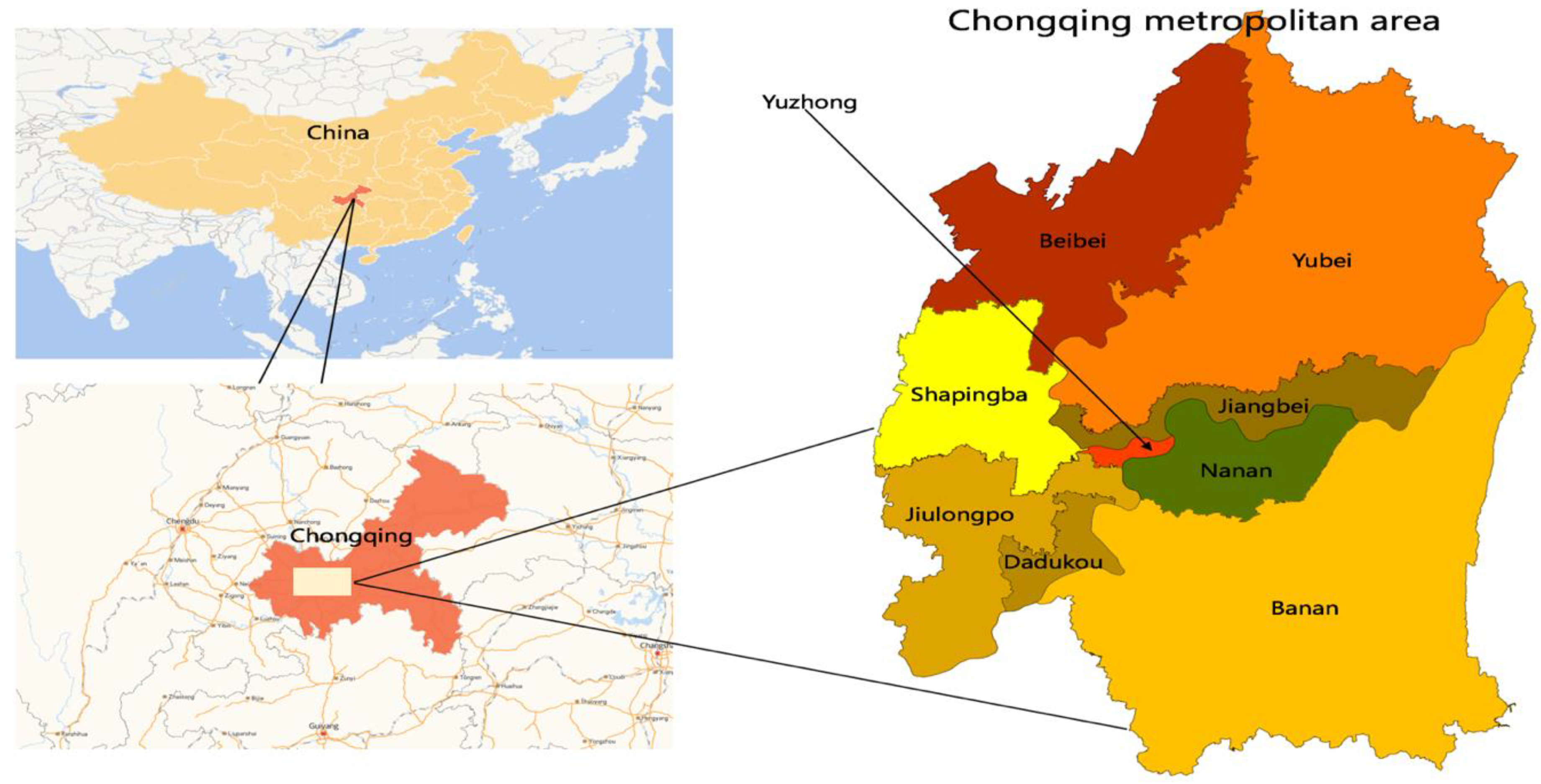
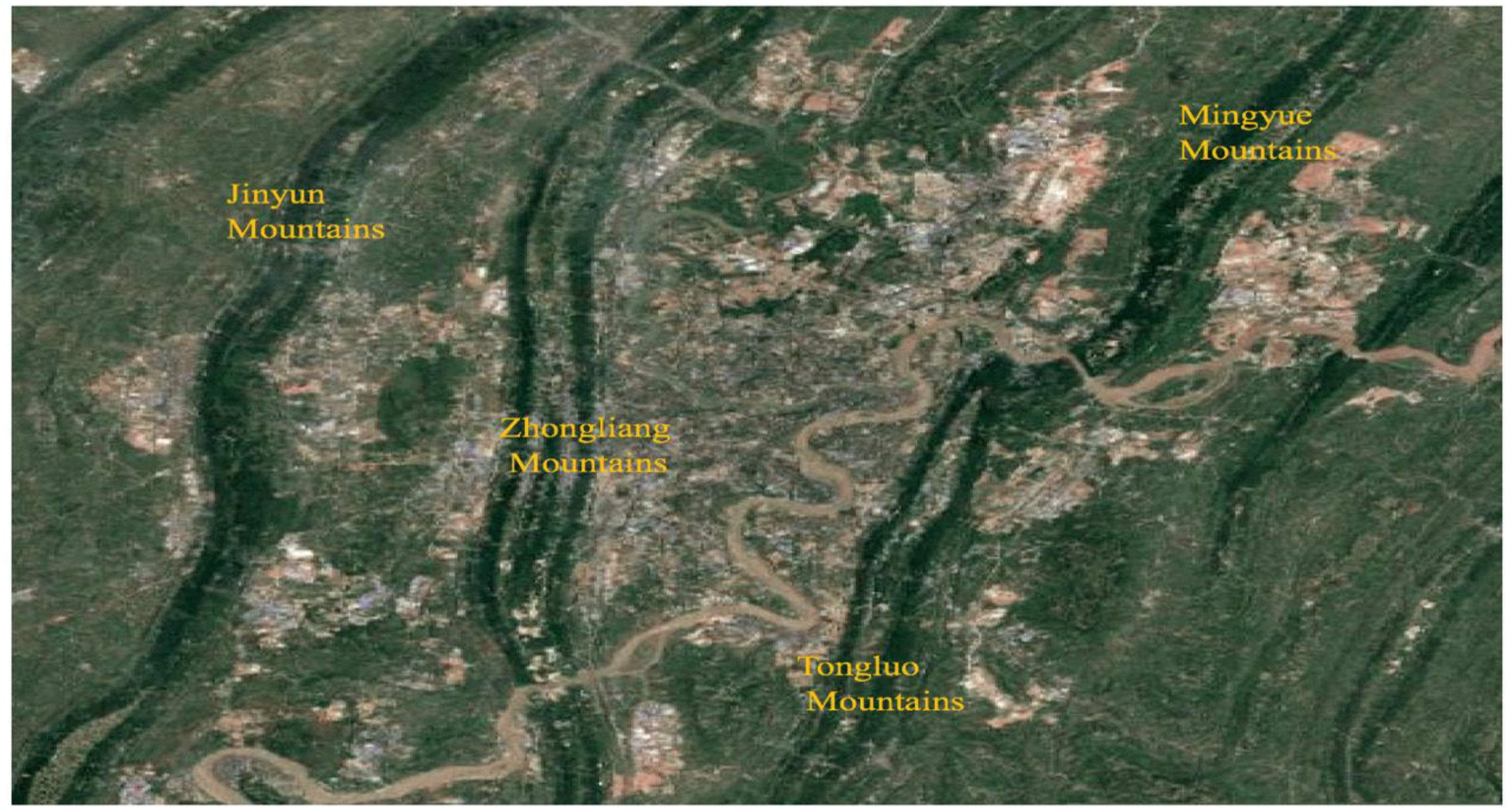
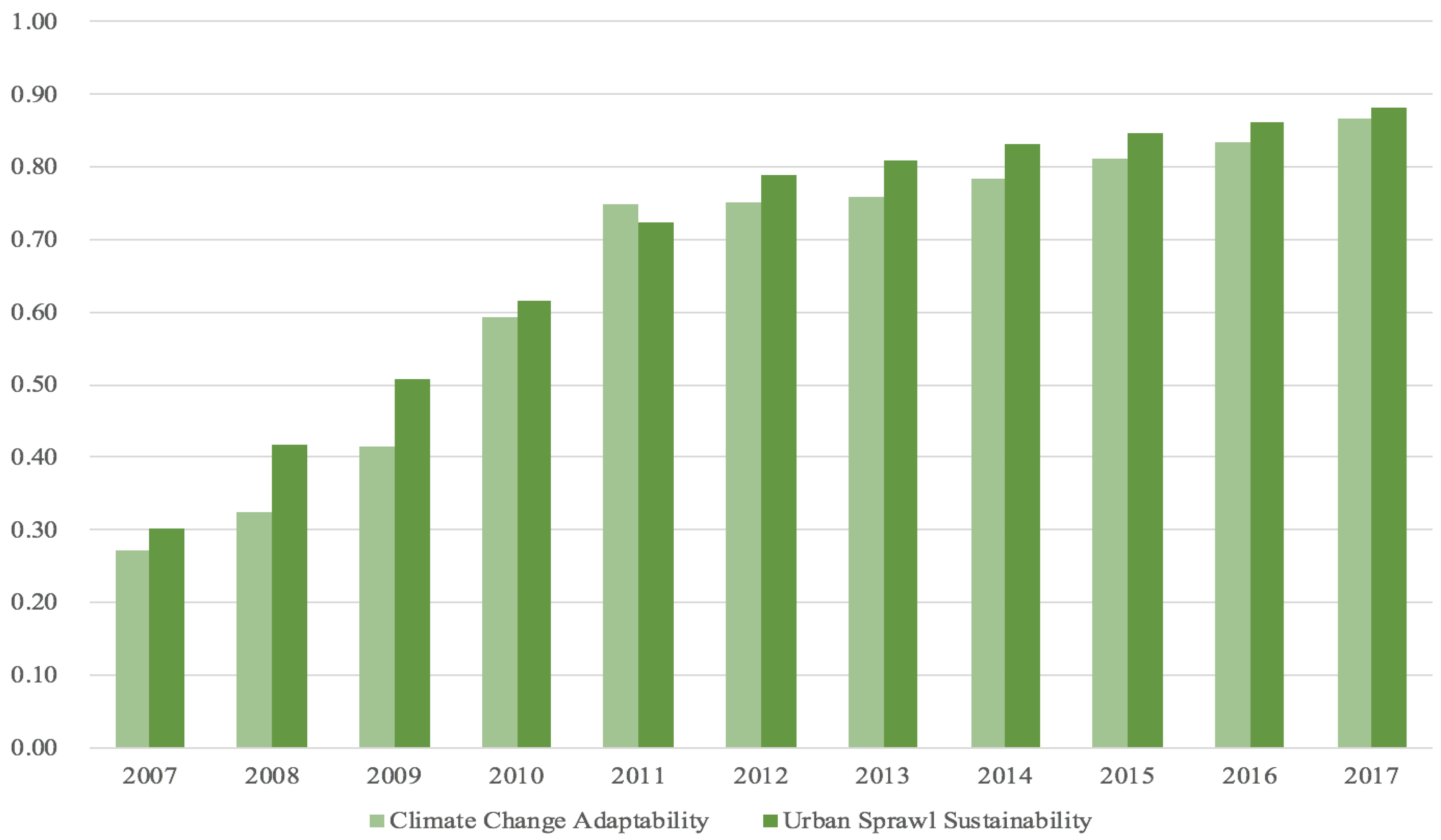
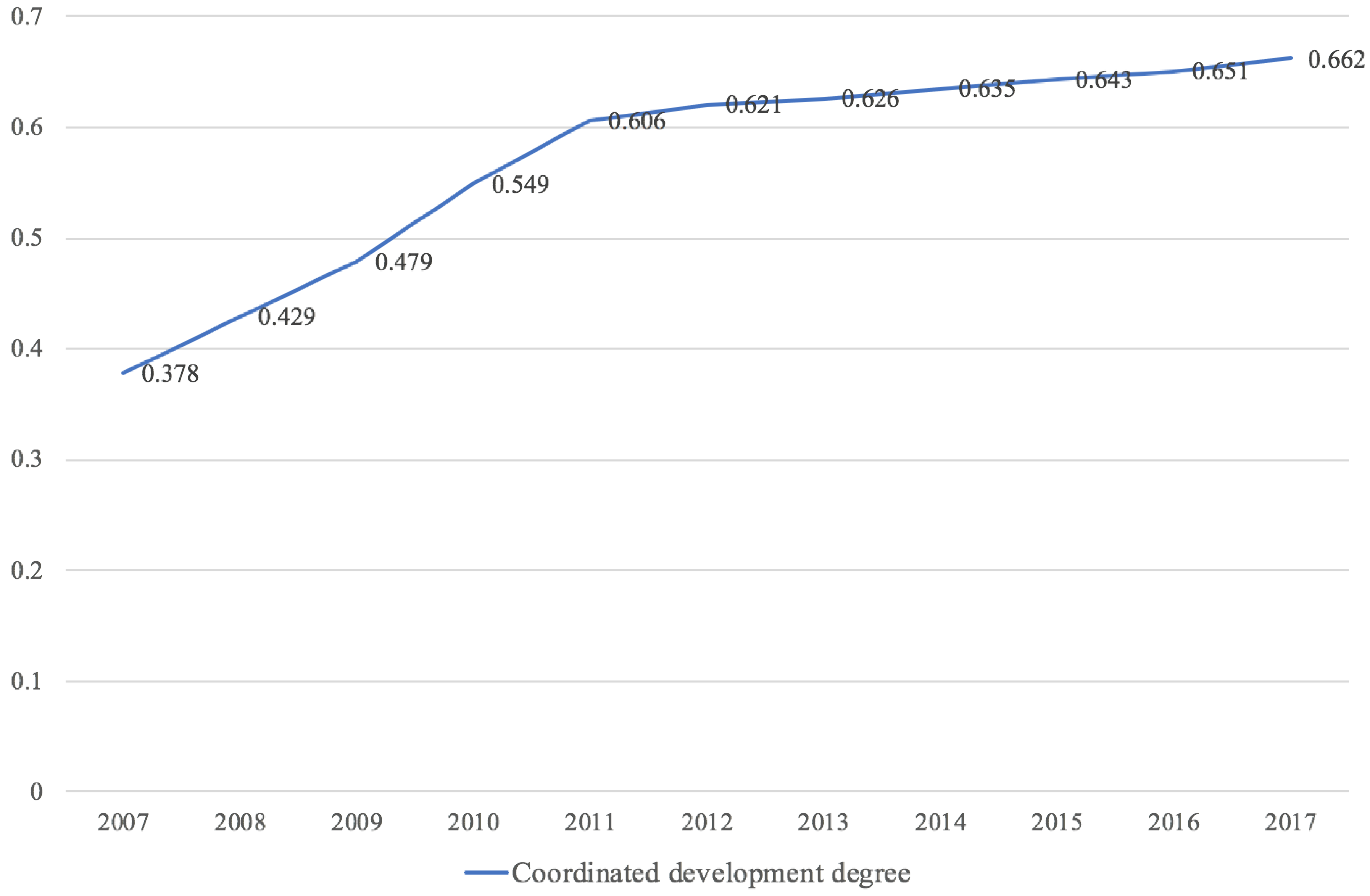
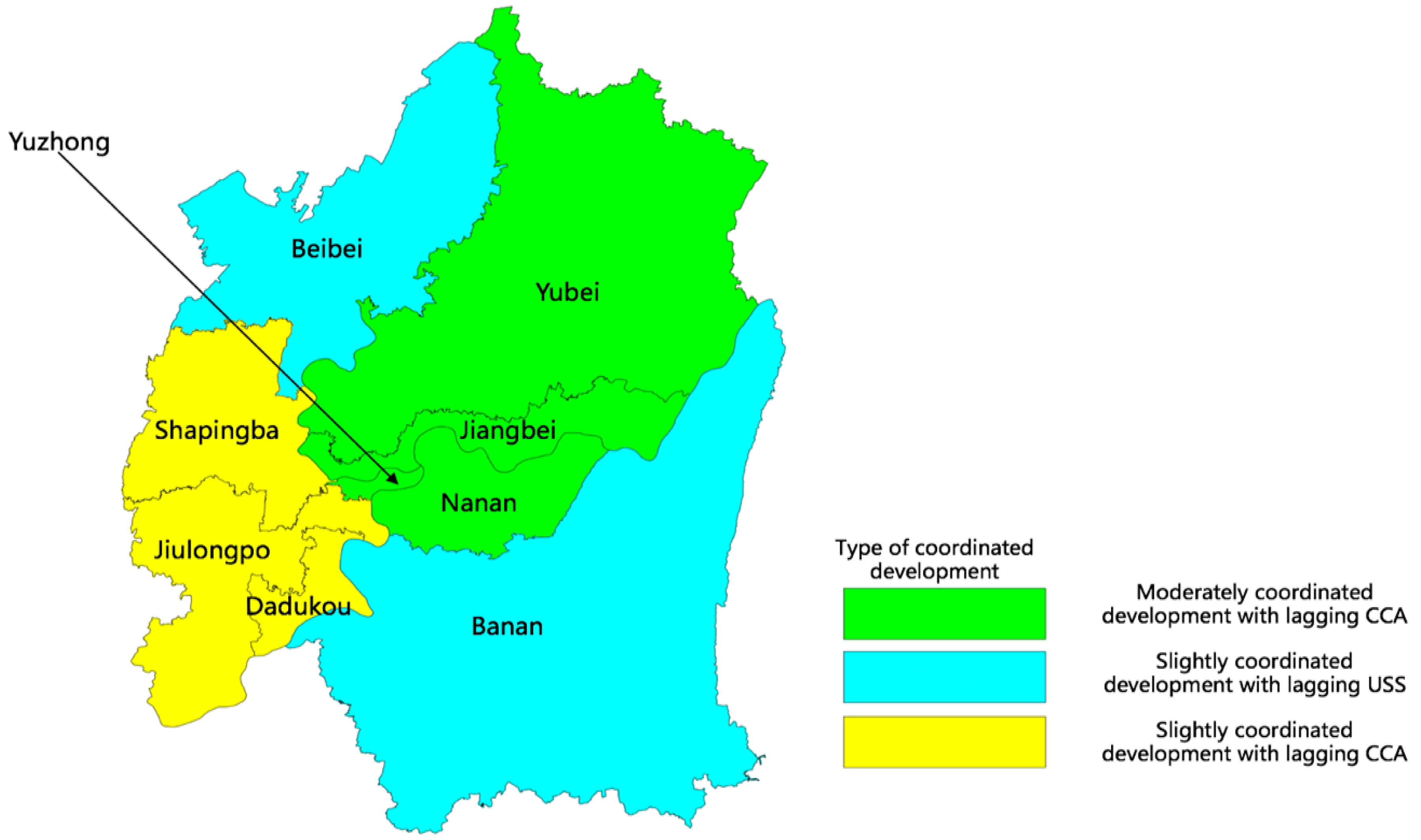
| Primary Indicators | Weight | Secondary Indicators | Weight |
|---|---|---|---|
| Population sprawl | 0.261 | Urban household population proportion (%) | 0.038 |
| Urban population density (persons/km2) | 0.102 | ||
| Urban natural population growth rate (‰) | 0.095 | ||
| Urban floating population (10,000 people) | 0.026 | ||
| Economic sprawl | 0.274 | Per capita GDP (Yuan) | 0.105 |
| Economic growth rate (%) | 0.064 | ||
| Per capita disposable income of urban households (Yuan) | 0.069 | ||
| Proportion of added value to GDP from secondary and tertiary industries (%) | 0.036 | ||
| Spatial sprawl | 0.257 | Highway mileage (km) | 0.036 |
| Built-up area (km2) | 0.073 | ||
| Urban spatial intensity (%) | 0.097 | ||
| Operational mileage of urban rail transit (km) | 0.051 | ||
| Social sprawl | 0.208 | Popularization rate of compulsory education (%) | 0.027 |
| Urban social security coverage (%) | 0.021 | ||
| Road area per capita (km2/per capita) | 0.023 | ||
| Per capita household electricity consumption (ton/per capita) | 0.068 | ||
| Urban rail transit per capita mileage (km/per capita) | 0.031 | ||
| Centralized treatment rate of sewage and refuse (%) | 0.038 |
| Primary Indicators | Weight | Secondary Indicators | Weight |
|---|---|---|---|
| Climate change pressure | 0.325 | Extreme minimum temperature (°C) | 0.032 |
| Maximum daily precipitation (mm) | 0.026 | ||
| Annual mean temperature (°C) | 0.035 | ||
| Annual precipitation (mm) | 0.028 | ||
| Percentage of sunshine (%) | 0.029 | ||
| Total energy consumption (10,000 tons of standard coal) | 0.081 | ||
| Total urban water consumption (10,000 tons) | 0.024 | ||
| Total industrial wastewater discharge (10,000 tons) | 0.037 | ||
| Total carbon dioxide emissions (million tons/MT) | 0.033 | ||
| Climate change state | 0.324 | Green area coverage rate in built-up area (%) | 0.061 |
| Per capita public green area (%) | 0.084 | ||
| Groundwater resources (m3) | 0.078 | ||
| Per capita water resources (m3) | 0.101 | ||
| Climate change response | 0.351 | Air quality standard days (days) | 0.027 |
| Industrial wastewater discharge compliance rate (%) | 0.101 | ||
| Industrial SO2 removal (10,000 tons) | 0.052 | ||
| Comprehensive utilization of industrial solid waste (10,000 tons) | 0.067 | ||
| Environmental protection investment as a percentage of GDP (%) | 0.039 | ||
| Total carbon emission reduction of domestic waste (10,000 tons) | 0.065 |
| Degree | Grade | Level |
|---|---|---|
| 0–0.09 | Extreme uncoordinated development | Uncoordinated development |
| 0.10–0.19 | Seriously uncoordinated development | |
| 0.20–0.29 | Moderately uncoordinated development | |
| 0.30–0.39 | Slightly uncoordinated development | |
| 0.40–0.49 | Barely uncoordinated development | Transitional development |
| 0.50–0.59 | Barely coordinated development | |
| 0.60–0.69 | Slightly coordinated development | Coordinated development |
| 0.70–0.79 | Moderately coordinated development | |
| 0.80–0.89 | Exceedingly coordinated development | |
| 0.90–1.00 | Superiorly coordinated development |
| Year | 2007 | 2008 | 2009 | 2010 | 2011 | 2012 | 2013 | 2014 | 2015 | 2016 | 2017 |
|---|---|---|---|---|---|---|---|---|---|---|---|
| Climate change adaptability | 0.273 | 0.325 | 0.415 | 0.592 | 0.749 | 0.752 | 0.759 | 0.785 | 0.812 | 0.835 | 0.866 |
| Urban sprawl sustainability | 0.301 | 0.417 | 0.508 | 0.615 | 0.723 | 0.789 | 0.808 | 0.831 | 0.847 | 0.863 | 0.883 |
| Coordinated development degree | 0.378 | 0.429 | 0.479 | 0.549 | 0.606 | 0.621 | 0.626 | 0.635 | 0.643 | 0.651 | 0.662 |
| Yuzhong | Yubei | Jiangbei | Shapingba | Jiulongpo | Dadukou | Beibei | Banan | Nanan | |
|---|---|---|---|---|---|---|---|---|---|
| CCA | 0.882 | 0.885 | 0.872 | 0.839 | 0.824 | 0.806 | 0.904 | 0.899 | 0.855 |
| USS | 0.951 | 0.921 | 0.905 | 0.899 | 0.862 | 0.812 | 0.822 | 0.819 | 0.903 |
| D1 | 0.721 | 0.715 | 0.713 | 0.658 | 0.649 | 0.635 | 0.656 | 0.655 | 0.701 |
© 2018 by the authors. Licensee MDPI, Basel, Switzerland. This article is an open access article distributed under the terms and conditions of the Creative Commons Attribution (CC BY) license (http://creativecommons.org/licenses/by/4.0/).
Share and Cite
Wang, Y.; Xiang, P. Urban Sprawl Sustainability of Mountainous Cities in the Context of Climate Change Adaptability Using a Coupled Coordination Model: A Case Study of Chongqing, China. Sustainability 2019, 11, 20. https://doi.org/10.3390/su11010020
Wang Y, Xiang P. Urban Sprawl Sustainability of Mountainous Cities in the Context of Climate Change Adaptability Using a Coupled Coordination Model: A Case Study of Chongqing, China. Sustainability. 2019; 11(1):20. https://doi.org/10.3390/su11010020
Chicago/Turabian StyleWang, Yiming, and Pengcheng Xiang. 2019. "Urban Sprawl Sustainability of Mountainous Cities in the Context of Climate Change Adaptability Using a Coupled Coordination Model: A Case Study of Chongqing, China" Sustainability 11, no. 1: 20. https://doi.org/10.3390/su11010020
APA StyleWang, Y., & Xiang, P. (2019). Urban Sprawl Sustainability of Mountainous Cities in the Context of Climate Change Adaptability Using a Coupled Coordination Model: A Case Study of Chongqing, China. Sustainability, 11(1), 20. https://doi.org/10.3390/su11010020




